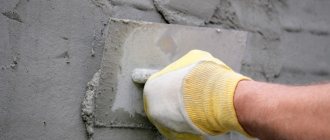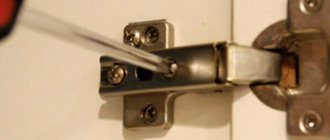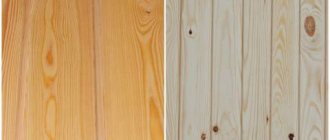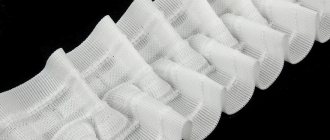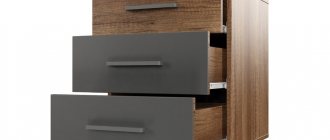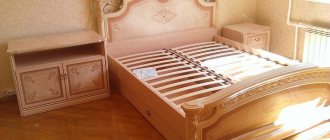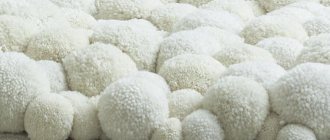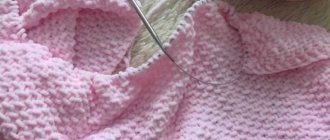Knitted yarn - features, advantages
Yarn made from knitwear has some features:
- elasticity - the material is very stretchable, and the wound bobbin itself makes it possible to knit two parts at the same time, since it unwinds not only from the outer end, but also from the inside;
- beautiful texture - products made from such material are not flat, but very voluminous, lush, seem airy;
- long service life - the color of the yarn does not fade over time, and the objects knitted from it themselves delight with their appearance for many years;
- affordable price - the cost of the material is low, as is its consumption, due to the relatively large thickness;
- a variety of colors and shades - from “classic”, monochrome, to overly bright options;
- knitting a product of any size from knitted yarn occurs quickly - literally in a matter of hours the item is ready;
- ease of working with the material - the threads are quite thick, smooth, soft, pleasant to the touch. Even a person with impaired vision can knit from them - it is almost impossible to skip a stitch here;
- Caring for a finished carpet or other similar item is not at all difficult, since the material holds its shape well and can be easily washed if necessary.
The consumption of “T-shirt” yarn depends on the knitting density, pattern, and thickness of the tools.
Chair back mat
It is better that the style of the chair seat is repeated in the cape on its back. Therefore, to make a cape from a small rug from the previous paragraph, you can sew additional elastic bands on the back side of the product. So that it stays on the back. Or you can make a full-fledged cape that will cover both the seats and backs of chairs or armchairs.
Tools:
- knitting needles, hook;
- yarn.
Manufacturing
- 60 stitches are cast on the knitting needles.
- Divide the set of 15 loops. These will be the sections for placing the picture.
- At the end you need to close all the loops.
- The rug itself is tied with threads in two single crochets three times.
If desired, the product can be decorated with fringe. There are also options when 3 to 5 shades of the same color are woven into the snake, creating a smooth, beautiful gradient in the design.
Thick yarn is voluminous threads made from wool with the addition of synthetic threads.
How to make your own yarn
Knitted strips are cut from any old, unnecessary things:
- T-shirts, T-shirts;
- stockings, tights, socks;
- dresses, jumpers;
- knitted skirts, pants.
To start making yarn, all unnecessary places are cut off from the knitted product - armholes, turns, decor, etc. The remaining part is cut in a spiral, in a strip, with a width of one and a half to two cm. When winding the tape into a ball, it will spontaneously curl into a rope.
Not only knitwear can be used for work. Rugs for the bathroom, toilet, hallway, where a large amount of dirt and dust is “worn around,” are made from polypropylene “yarn” cut from colored bags. The latter can be new or used. There is also colored polypropylene store-bought twine - it is sold in skeins of 50-100 meters or more.
Plastic bags for knitting floor mats
Surprisingly, rugs can even be knitted from plastic bags! Our inventors learned how to make ribbon-type yarn from them.
At one time, such knitting became incredibly popular.
Garbage bags are better suited for rugs; they come in different colors, so you can choose the one that suits you. Needlewomen advise taking bags that are not very thick to make knitting more convenient.
Polyethylene rugs are moisture-resistant and durable. This is an ideal option for the bathroom, they don’t slip even on a wet floor, and when leaving the bathroom, you don’t have to be afraid of slipping on them, water doesn’t accumulate under them, and they dry quickly enough.
Consumption of packages: unknown, I haven’t found such information anywhere, probably no one counts the number of packages. But buy them with a reserve, if you suddenly don’t have enough, it’s not a fact that you will find the same color after a while.
Hook: 3.5-4.
Disadvantages : according to reviews, the rugs do not always turn out even, you need to make precise increments in the circles (if the rug is round) so that it does not tighten or, conversely, does not go into waves. Such a finished rug cannot be straightened or ironed.
Also, rugs made from bags are not suitable for rooms in an apartment; they are only suitable for a bathroom, hallway or balcony, that’s my opinion.
Selection of finished yarn
Knitting yarn is usually made from the highest quality Turkish knitwear. There are two versions available: primary and secondary production. These two types differ in the way they cut raw materials. Products made from primary yarn are perfectly smooth, and the material itself is made of solid knitted fabric. The secondary one is made from the remnants of knitwear, including substandard ones, therefore the slight presence of knots, imperfections, or hard joints is not considered a defect. The differences in color, gloss, and strength characteristics of both materials are quite insignificant.
They also differ in price (the primary yarn is an order of magnitude more expensive), as well as in the way the yarn is twisted - the secondary yarn is twisted “face” outwards, cut along the fabric, which is very convenient for beginners who are knitting with it for the first time.
We knit a pentagonal rug according to the pattern
Crocheted rugs can come in different shapes. For example, a pentagonal canvas according to the pattern. A soft knitted yarn will do. We start work with a circle. We cast on 5 VP, 1st row is knitted like this: 3 VP, 2 Dc in the first loop, 2 VP, 3 Dc, 2 VP. We make five rows in a circle, the second one is knitted like the first, only after 3 dcs we knit 1 ch. Next, follow the diagram, and finish the corner of the star separately. The diagram can be easily found on the Internet.
Rugs can be of completely different shapes
Ways to create rugs
There are several options for how to create a rug:
- crocheting, knitting;
- creation from mesh and knots;
- knitting "on hands";
- made using patchwork technique;
- weaving using a frame, hoop;
- stitching from several parts;
- from small pillows, pompoms;
- mixed techniques.
Using any of these methods it is easy to create not only a bedside rug, but also a bedding for a pet, a cover for a stool, etc.
Knitting
Knitted carpets are the most popular option. To knit from knitted material you will need a hook or knitting needles with a thickness of 9-15 mm. The work is usually done according to a certain pattern. Here are some simple options:
- The round rug is crocheted from the center using double crochets or single crochets. Increases are made in each row, 6-8 loops. The height of one row is up to two cm, each of them can be made in a different color;
- to make a square rug, it is also knitted from the middle, but increases are not made evenly along the entire perimeter, but only in four places - in each row in the same place, knitting four or five loops at once;
- to create an oval rug, make a chain of ten or more air loops and tie it in a circle;
- In order to knit a figured product using a hook, they draw a sketch and make a pattern of the desired size and shape. A solid item begins to be knitted from one of the edges or the center, periodically checking with the template. A structure of several parts is “broken” into sections, each fragment is made separately, and then connected to each other, enclosing it in a common knitted outline;
- To make an openwork carpet with crochet or knitting, appropriate patterns are used, replete with air loops, chains of such loops. Knitting is done from the edge or middle;
- Using knitting needles, a square rug is knitted from the corner, adding one loop at the end of each row. It is recommended to crochet the finished fabric along the edge to hide the unsightly edge. Knitting from the edge is easier, but it is not advisable to knit in satin stitch, as the item will curl slightly;
- “Hand knitting” is done similarly to knitting with knitting needles, instead of which one’s own limbs are used. In this case, the yarn is folded into three or four rows, and the carpet itself comes out very thick.
Weaving
Weaving is done using the macrame technique, using several types of knots - individual “threads” are tied to each other. To make the product even, pieces of yarn, the length of which exceeds the expected dimensions of the carpet by 6-8 times, are secured to a crossbar or a series of nails driven into the board. The distance between the latter is one to one and a half cm.
No less often, the carpet is woven on a plastic gymnastic hoop, wooden or wire frame of any shape and size. Jute twine is used as the base with which the yarn is woven. This is a natural material, sold in the form of a rope, with a thickness of two to three mm or more. It is pulled onto the frame by simply wrapping it in a spiral, maintaining a distance from thread to thread of 7-10 mm. Weaving is done according to the tapestry principle, by alternating pulling the yarn under and over the warp thread, observing a checkerboard pattern. When weaving on a round hoop, all the warp threads pass through the center; you need to weave it like a tapestry.
There is also a knotted version of weaving a “fluffy” rug. You will need a frame with threads stretched in the form of a mesh or a ready-made mesh tightly, with cells 0.5 by 0.5 cm or 0.8 by 0.8 cm. The yarn is cut into pieces of 10-15 cm, each of them is tied on the mesh until it will not be completely filled. The edges can be decorated with lace.
Stitching
The stitching of a soft rug is made from many tiny pads made from pieces of knitwear with any padding. The dimensions of the parts are from three to four cm, the shape is any. The product is sometimes made from asymmetrical fragments, but more often from round ones. The pads are attached to each other with matching threads and sewn onto a piece of thick fabric of a suitable shape. It is not necessary to make the item monochromatic - options with patterns, flowers, in the form of animals and birds look the most interesting.
There is another option that allows you to create a round, uniform carpet. To make it, a braid is woven from three to five ribbons of yarn, about four cm wide. Afterwards, the resulting braid is laid in a spiral snake in a circle, starting from the center and imperceptibly fastened with sewing threads every two to three cm.
Patchwork
The patchwork technique is patchwork sewing. To do it yourself, you will need fabric of different colors - at least two to four, but the more, the more interesting the item will be. Textiles are cut into squares, less often into triangles, polygons of the same size, which are sewn together from the wrong side on a sewing machine. The resulting fabric is sewn onto a thick textile base, the edges are decorated with bias tape.
Products made from denim look good - the edges of the parts do not need to be tucked, you just need to sew each square with small machine stitches, departing 5-7 mm from the outline, leaving a short fringe. It is acceptable to use pockets, asymmetrical details, overlapping and inconsistent.
Knitting rugs from acrylic and wool yarn
You can also knit rugs from regular knitting yarn: wool, half-wool, acrylic.
For this purpose, a thick thread, known to us as Karachaevskaya, is best suited. This is on sale in all stores everywhere and costs 25 rubles per skein of 40 grams, and is also sold in skeins.
The composition is acrylic + wool blend and is very reminiscent of country yarn. It has a rough texture, which is ideal for carpets.
I have experience in knitting a rug from circle motifs and a Japanese rug from rings.
I think this is the best yarn for these types of projects. The rugs are soft and perfectly convey the texture of such a handmade rustic rug. They are easy to wash, do not stretch out, do not shrink after washing, keep their shape perfectly, which is very important - they do not fade at all, so you can use different colors in one product. And the low cost of yarn is a significant plus.
I recommend knitting rugs in two or three folds. In skeins, yarn comes in two or three twisted threads. If it has two twists, then knit it in three folds; if it has three twists, then knit it in two folds. And for the durability of the product, you can include a jute thread in the edge, this will add rigidity, the edge will be smooth and beautiful.
Consumption: for a rug with a diameter of 80 cm - about 500 grams of yarn.
Hook: No. 6.
Flaws . This yarn has no flaws! It is not suitable for knitting openwork blouses, but for rugs it is ideal!
Shape, product size
An original carpet, made independently, can be made in any possible shape:
- round, oval;
- rectangular, square;
- U-shaped or crescent-shaped;
- in the shape of a star, snowflake;
- like a flower with petals.
Knitted items for a children's bedroom are made in the form of bunnies, cats, fish, bears, penguins, houses, Christmas trees, “Smeshariki”, etc. It all depends on the imagination of the parents and the kids themselves.
The approximate yarn consumption for an item measuring one square meter is 4-5 skeins of yarn, with an average knitting density.
Fluffy rug “Sheep”
You can knit a rug with knitting needles creatively and not difficult if you resort to a trick. The “Sheep” product consists of 80% pompoms and only 20% knitted part.
Tools:
- knitting needles;
- brown yarn;
- white or beige threads of yarn;
- sewing thread and needle.
Manufacturing
Pompoms are made from threads of a lighter shade. To make it, you need to wind a certain amount of thread on your folded palm. The ends left at the beginning of winding and at the end must be tied together. The resulting skein is cut and a pompom is obtained.
The body and head are made flat, so no great knitting skills are needed. To make it you will need:
- 4 straight strips for limbs;
- 2 small triangles;
- 1 large triangle for the head.
Important! One of the tips on how you can creatively improve the product is to make pom-poms that imitate the body of a sheep in different sizes. This will make the rug more voluminous.
Rug “Sheep” – knitted, plus pom-poms.
Color scheme, style
Homemade rugs are appropriate in every room and in almost any interior style:
- loft - crocheted products will fit well into such an interior. The preferred color scheme is brown-gray, beige-reddish, any wood shades;
- modern - plain rugs of simple shape are recommended. If there are several of them in one room, it is permissible to make one bright and accent;
- hi-tech - the main colors here are gray, blue, silver. Items made from textiles with lurex are perfect;
- country - checkered options, knitted from many individual squares and rectangles. Coloristic solution – black-red, gray-burgundy, etc.;
- retro - products cut from knitwear or jeans made using the patchwork technique are suitable here;
- boho - all items are as bright and colorful as possible. Primary colors – burgundy, velvet green, yellow-orange, deep blue, copper, etc.;
- Japanese - round, square rugs in neutral, mostly light colors are scattered everywhere here, replacing chairs.
Modern hobbies with great experience
Many people are interested in knitting today. This is not just an interesting activity. It helps you concentrate and at the same time calms your nerves. Over a certain period of time, human hands create a “knitted masterpiece”, pleasing to the eye and warming in cold seasons.
Knitted items can decorate a variety of areas in an apartment or house. Their locations may be:
- floors in central rooms;
- floor in the bathroom and toilet;
- floor in the hall or corridor.
At the same time, in the above places, where a floor rug already represents one of the types of interior design, the same decorative product can be used as a covering for stools and chairs. They can be used to decorate chests of drawers, bedside tables, and lower cabinets for storing shoes, which also serve as seats in hallways.
For many, it is important to somehow transform their home. Ultimately achieve a cozy atmosphere. For needlewomen who love to create, knitting rugs is a good way to train and develop their creative abilities.
And the question of where to then adapt the product can be resolved quickly. Your imagination will tell you how best to use your own crocheted rug.
Examples of using knitted rugs in various rooms
If desired, different beautiful rugs are made for each room of the apartment or house:
- in the nursery - the floor in the child’s room is a place for games, so you can’t do without a lot of carpets. The item is usually made motley, very bright;
- for the bathroom - this room is characterized by high humidity, therefore the rug is often woven from terry towels turned into yarn, which perfectly absorb water;
- in the kitchen - in this room, most things encounter an abundance of fat, moisture, pieces of food, drops of spilled drinks, therefore the carpet is recommended to be made of polypropylene, which is easy to wash;
- for the toilet - here the mat is placed in front of the toilet, so a corresponding cutout is made in the back of it. The product resembles a crescent or the letter “C”;
- in the hallway - in the corridor I place a rug directly in front of the door or create a “path”, using it to decorate the entire length of the room. The door mat is made of polypropylene;
- for the living room - a large, luxurious product is made here. The larger the room, the larger the carpet is made - too small it looks poor, and it will simply get lost in the space;
- to the bedroom - a bedside carpet is made for this room. If you have a work desk or dressing table - a product that is placed under your feet while working or applying makeup;
- for an office - usually in a simple home office room they do without unnecessary decor, so a round knitted or wicker floor decoration can become the only accent;
- on a balcony or loggia - the rug here serves the function of protecting feet from the cold of the concrete floor, especially for unglazed spaces. A compact item is placed in front of the entrance indoors, a large item is placed to cover the entire floor.
How to crochet a round rug
A round rug will also look good from rows of posts under the back wall of the loop.
A pattern for knitting a circle is attached.
I think everyone knows the principle of knitting a circle.
In the second row we knit two stitches from each loop of the previous row. In the third row we make increases in every second column (i.e. through a loop), in the fourth - in every third column, in the fifth - in every fourth and so on.
You can also watch a detailed video tutorial from Olga Papsueva on how to crochet a round rug.
To make the rug even more beautiful, you can diversify it not only by knitting rows of different colors, but also with openwork hems. I made a video in which I tried to show the principle of how to knit such a rug, but here you need to individually select the number of loops for each tier. Here are some more rugs made from small circles that even a beginner can easily handle. And they look amazing, beautiful, stylish and unusual:
Yarn structure for a specific room
To crochet a rug according to the pattern and description, you need to choose not only the color of the yarn, but also its composition. As for the structure of the yarn, then, as mentioned above, it all depends on which room the product is knitted into. If this is a room where there are often a lot of people and where you have to clean it often (the kitchen, for example), then it is worth knitting a smooth, dense rug, which will then be easy to vacuum or shake out. And for the bedroom it’s worth making some more comfortable option. It can be fluffy or made from some softer and more pleasant yarn, which will be a pleasure to walk on with bare feet.

